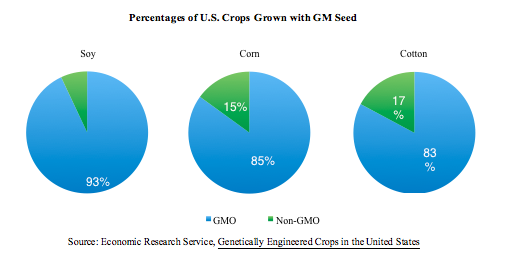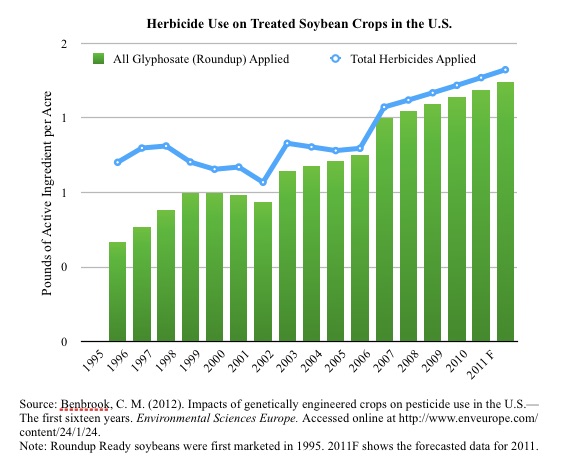By Sanaz Arjomand, M.S. in Environmental Policy 2016
In my opinion, fighting to label genetically modified (GM) organisms (a.k.a. GMOs) is a misallocation of the energy and enthusiasm of the sustainable food movement. Concerned consumers can already purchase organic (since GMOs are not allowed under USDA certification) or look for a reputable GMO-free label such as the Non-GMO Project verification seal.
And yet, I’m chiming in because I disagree with the idea that all people who aren’t thrilled about GMOs are under the spell of fear mongers who are ignorant of scientific research. Although I am not involved with the movement for labeling GMOs, I find that there are valid reasons to be wary of GMOs, particularly where the environment is concerned.
Pictures featuring a fish tail growing out of a tomato are scary, but they do not paint a true picture of the main goals of genetic modification. In the United States, GM crops generally have been bred for two traits:
- Herbicide tolerance, as in “Roundup Ready” soy that can be sprayed with the weed-killer glyphosate with no damage)
- Insect tolerance, as in corn containing genes of the insecticidal bacterium Bt to kill corn rootworm or cotton containing the same genes to kill the cotton bollworm.
That being said, here are some facts about GMOs that I do not intend to dispute:
- There’s some precedent: Human beings have been “genetically modifying” crops (through less technical methods such as selective breeding and cross-pollination) since the dawn of agriculture—without dangerous health consequences.
- They’re considered safe: GMOs have not been proven unsafe for human consumption.
- They decrease some inputs: The genetic modification of crops to contain their own pesticides can lead to less pesticide used overall.
- They can increase yields: Better pest resistance and higher yields per acre can have meaningful impacts for farmers who are able to afford GM seeds.
- They can be healthier: Though this is a less common goal of genetic modification, some crops have been modified in order to provide health benefits to eaters. Examples include the newly developed Innate potato that produces less acrylamide as it fries, or the much-hyped vitamin A infused Golden Rice that is intended to help those in developing countries obtain enough nutrients. Neither of these crops has been approved for human consumption.
Even understanding, believing, and fully internalizing these generally accepted scientific facts, I can’t say that I wholeheartedly support GMOs—especially as they appear in American fields and grocery stores.
Here are some facts about GMOs on the other side of the debate:
- They don’t work forever: So-called “superweeds” are developing resistance to the herbicide glyphosate from its use in GM crops, and more toxic alternatives may become the norm.
2. They increase other inputs: Roundup Ready crops mean that more herbicides are used now than before. And, although there is work being done to create crops that can produce their own nitrogen fertilizers, the GM crops grown now do not perform well without inputs of nutrients in addition to the herbicides listed above.
3. They don’t work for everything: Although genetic modification does hold promise for simple genetic traits (e.g., height) that can be easily isolated, more complex traits such as saline tolerance or drought tolerance are still best bred for using traditional methods.
4. They don’t stay put: In crops that are wind- or insect-pollinated, there is no way to control where the genetically modified DNA will spread.
5. They’re not “feeding America”: The GM crops grown in the United States are largely used for animal feed and biofuels.
Neither of these lists is exhaustive, nor is the information weighted in a way that makes them directly comparable. However, they do illustrate that neither side of the argument has a monopoly on science-based evidence.
There are people who are afraid that “frankenfoods” will somehow alter their own DNA, so I understand why scientists are concerned that the hype over GMOs is unfounded. What I don’t understand, though, is why so few commentators bring up the potential environmental costs of GM crops.
Though I have concerns about GM crops as a part of the U.S.’s unsustainable agricultural status quo, I am not ignorant of the arguments in their favor. Instead, I am looking to the big picture to see how the farming practices that grow what I eat affect my environment. The National Dietary Guidelines Committee—made up of scientists—recently took this stance in its latest nutritional recommendations. Why not join in when it comes to thinking about GMOs?


